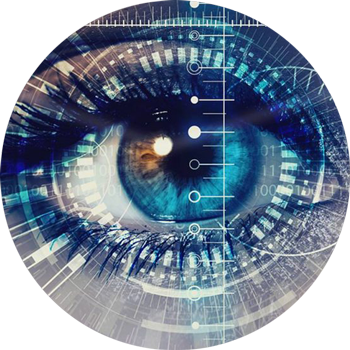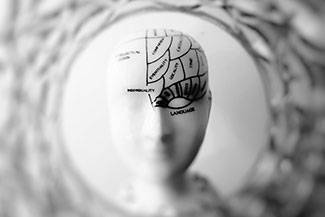Traumatic brain injury such as a concussion or stroke, or diseases such as MS, cerebral palsy, or chronic traumatic encephalopathy (CTE), can result in potentially devastating visual problems. There are also a number of inherited brain conditions which can similarly prevent the normal development of the visual system.

Is a Brain Injury or Concussion Affecting
Your Vision?
The effect these have on the neuro-visual system won’t always be noticeable early on, as many health care providers and therapists lack the training and/or skills to recognize when neural-visual problems are affected by brain damage. Even when they are recognized, the treatment needs to be provided by a neuro-optometrist. An optometrist or vision therapist trained in neuro-optometric rehabilitation can effectively treat and rehabilitate the vision-related problems in those who have or are suffering from visual deficits and dysfunction resulting from brain injury or disease.
Headed by Dr. Scott Lewis, the Focus Vision Therapy Center provides advanced neuro-optometric rehabilitation from our clinic in Eagle, Idaho. We work with patients to help them improve visual function, alleviate symptoms, and regain their quality of life. We provide neuro-optometric rehabilitation to patients from Eagle, Boise, Emmett, and Nampa.
What is Neuro-Optometric Rehabilitation?
The brain is surprisingly elastic, meaning it can rewire and retrain itself after injury. Neuro-optometry—often lumped in with vision therapy—is a specialized field of optometry which works to actively retrain and reprogram the visual processing we rely on to properly interact and interpret the world around us. Neuro-optometric rehabilitation uses a highly-customized combination of visual exercises, specialized lenses, and targeted visual stimuli—often including of digital aids—to retrain the patient’s brain to process visual input properly.
Dr. Scott Lewis will create a treatment plan based on the individual’s vision conditions and medical background. Neuro-optometric rehabilitation is an important component of the rehabilitative process and is essential to reclaiming full day-to-day vision functionality.

General Symptoms of Vision Conditions Treated by
Neuro-Optometric Rehabilitation
- Spatial disorientation
- Focusing problems
- Double-vision (diplopia)
- Blurred vision (asthenopia)
- Headaches
- Nausea and dizziness (vertigo)
- Eye strain
- Fatigue
- Problems accurately gauging movement, direction, and speed
- Trouble differentiating colors
- Hand-eye coordination and motor problems
Frequently Asked Questions About Neuro-Optometric Rehabilitation
Who is a Good Candidate for Neuro-Optometric Rehabilitation? How Do I Get Started?
Anyone with the above symptoms or conditions should undergo a neuro-visual or vision therapy assessment.
People with motor, perceptual, or visual problems resulting from brain injury or disease can benefit from neuro-optical rehabilitation. It begins with a general eye exam to ascertain the overall health of your eyes. After reviewing any relevant medical documentation from your neurologist, occupational therapist, physiotherapist, etc, Dr. Scott Lewis will then perform a Neuro-Visual Assessment to pinpoint the exact visual conditions(s) present. The Focus Vision Therapy Center will then craft a personalized treatment plan for your recovery.
How Long Does it Take for Neuro-Optometric Rehabilitation to Work?
This depends on the severity of the condition or problem. You should experience improvements fairly quickly. Don’t expect a complete turn-around overnight, however. It’s a gradual process— it takes time to retrain the brain and eyes to function in unison in the way that they should, particularly if the cause of the vision problem was severe. The full amount of time required depends on multiple factors, including the cause, the individual patient, and compliance with the regimen.
References
Faul M, Xu L, Wald MM, Coronado VG. Traumatic Brain Injury in the United States: Emergency Department Visits, Hospitalizations and Deaths
2002–2006. Atlanta (GA): Centers for Disease Control and Prevention, National Center for Injury Prevention and Control; 2010.
https://www.cdc.gov/traumaticbraininjury/pdf/blue_book.pdf
Report to Congress on Mild Traumatic Brain Injury in the United States: Steps to Prevent a Serious Public Health Problem. Atlanta (GA): Centers for Disease Control and Prevention, National Center for Injury Prevention and Control; 2003.
https://www.cdc.gov/traumaticbraininjury/pdf/mtbireport-a.pdf
Ciuffreda KJ, Kapoor N, Rutner D, Suchoff IB, Han ME, Craig S. Occurrence of oculomotor dysfunctions in acquired brain injury: a retrospective analysis. Optometry 2007;78(4):155-61.
https://www.ncbi.nlm.nih.gov/pubmed/17400136
Rowe F.J. Stroke survivors’ views and experiences on impact of visual impairment. Brain and Behavior, 2017; e00778 DOI: /onlinelibrary.wiley.com
/doi/epdf/10.1002/brb3.778
https://onlinelibrary.wiley.com/doi/full/10.1002/brb3.778
Leslie S. Myopia and Accommodative Insufficiency Associated with Moderate Head Trauma, Opt Vis Dev 2009;40(1):25-31.
https://cdn.ymaws.com/www.covd.org/resource/resmgr/ovd40-1/article_myopiaaccominsuff.pdf
Cohen, Alen H. Vision rehabilitation for visual-vestibular dysfunction: The role of the neuro-optometrist, NeuroRehabilitation, vol. 32, no. 3, pp. 483-492, 2013
HAN M.E. (2007) The Role of the Neuro-Rehabilitation Optometrist. In: Elbaum J., Benson D.M. (eds) Acquired Brain Injury. Springer, New York, NY













